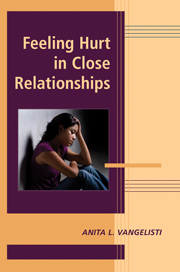Book contents
- Frontmatter
- Contents
- List of Contributors
- Foreword
- PART I INTRODUCTION
- PART II CONCEPTUALIZING HURT
- PART III HURTFUL ACTS
- PART IV HURT IN RELATIONAL CONTEXTS
- PART V HURT IN APPLIED CONTEXTS
- 17 The Physiology of Feeling Hurt
- 18 Hurt and Psychological Health in Close Relationships
- 19 Technology and Hurt in Close Relationships
- 20 Hurt Feelings and the Workplace
- 21 Cultural Influences on the Causes and Experience of Hurt Feelings
- 22 Hurt Feelings: The Last Taboo for Researchers and Clinicians?
- Author Index
- Subject Index
- References
18 - Hurt and Psychological Health in Close Relationships
from PART V - HURT IN APPLIED CONTEXTS
Published online by Cambridge University Press: 04 August 2010
- Frontmatter
- Contents
- List of Contributors
- Foreword
- PART I INTRODUCTION
- PART II CONCEPTUALIZING HURT
- PART III HURTFUL ACTS
- PART IV HURT IN RELATIONAL CONTEXTS
- PART V HURT IN APPLIED CONTEXTS
- 17 The Physiology of Feeling Hurt
- 18 Hurt and Psychological Health in Close Relationships
- 19 Technology and Hurt in Close Relationships
- 20 Hurt Feelings and the Workplace
- 21 Cultural Influences on the Causes and Experience of Hurt Feelings
- 22 Hurt Feelings: The Last Taboo for Researchers and Clinicians?
- Author Index
- Subject Index
- References
Summary
Where there is love, there is pain.
– Spanish proverbExperiencing hurt is an inevitable part of being in a close relationship. The depth of feeling and emotion that come from loving another brings with it in equal measure the potential for pain and anguish. This conundrum is arguably the most frequently explored theme in art, literature, and religious thought. Despite the pain that inexorably follows love, the vast majority of individuals in Western culture continue to invest themselves in love, marriage, and family (Gallup, 2006). The happiness associated with loving relationships such as marriage is substantial and is well documented in psychological research. However, the hurt associated with love is also substantial, and its sequelae have also been documented. This hurt born of love often goes beyond temporary feelings of sadness or disappointment and is linked to psychological distress.
The first section of the chapter examines the relationship between experiencing hurt in close relationships and mental health. We discuss experienced hurt in relation to chronic and discrete transgressions and provide prototypes to illustrate how reactions to each type of event may be related to psychological health. In the second section, we propose a conceptual model in which forgiveness mediates the relationship between hurtful events and mental health. We also explore some potential moderators that may influence the forgiveness process. Finally, we make suggestions for future research.
- Type
- Chapter
- Information
- Feeling Hurt in Close Relationships , pp. 376 - 399Publisher: Cambridge University PressPrint publication year: 2009
References
- 3
- Cited by



